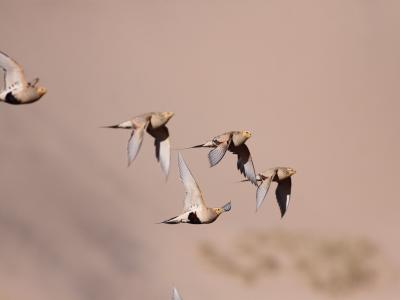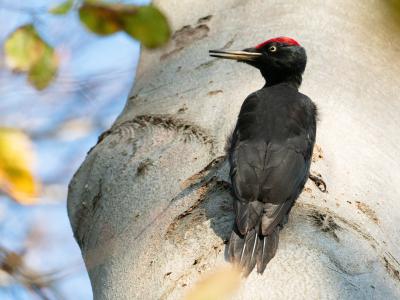Poland in Spring
-
May 14-21, 2025
Stephen Menzie
-
May 2027
Stephen Menzie
2025
Single Room Supplement $360
2027
Tour Price to be Determined
2025
Single Room Supplement $360
2027
Tour Price to be Determined
Birding in Eastern Poland in late May is magical. Every mile of road has at least one pair of White Storks nesting on top of a roadside telegraph pole, the incessant crex crex call of Corncrakes, and Common Cuckoos seem to be in every patch of woodland or reed. The general area hosts a range of habitats, from the extensive Biebrza Marshes – home to a significant proportion of the world’s breeding Aquatic Warblers – to the primeval Bialowieza Forest. Accordingly, a wide variety of species can be encountered, many in numbers seldom found elsewhere in Europe.
Day 1: The tour begins this evening in Warsaw, Poland. Night in Warsaw.
Days 2-4: We’ll leave Warsaw travelling northeast towards the city of Bialystok and Biebrza National Park (Bialowieza Park Narodowy). We’ll make several stops on route, including for one of Europe’s fastest declining species, Ortolan Bunting. Our first glimpses of the extensive marsh complexes might reveal our first White-winged Tern, and we’ll keep an eye out for White-tailed, Lesser Spotted and Greater Spotted Eagles.
Polish dinners tend to be served relatively early, opening up the evening for birding…and it’s a great time to visit the marshes We’ll go to a site that, in some years, holds a Great Snipe lek, although the site has become overgrown in recent years. Even if the snipe are not present when we visit, the evening is sure to be memorable, with multiple Eurasian Woodcocks ‘roding’ over the surrounding woodland, and a host of ‘night singers’, including Thrush Nightingale, Grasshopper Warbler and Tawny Owl.
As we may have been up late last night, we’ll have a relaxed start to day 3. We’ll visit an accessible area of marshland close to the hotel that holds breeding Aquatic Warbler, and explore a nearby nature reserve where we’ll look for Savi’s Warbler, Penduline Tit and, if we’re lucky, Little Crake or a Great Grey Shrike. We’ll finish the morning with a drive along the famous (and bumpy!) Tsar’s Road, which runs along the spine of the national park, in search of woodland species, such as Icterine and Wood Warblers, Red-breasted Flycatcher and Hawfinch.
After lunch, we’ll explore an area of flooded meadow that, in most years, holds breeding White-winged and Whiskered Terns. Depending on which area of the meadow they’re nesting in, views can be as close as a few tens of yards as they hawk for insects by the side of the road. As evening arrives, we’ll follow a short boardwalk that runs out into the marshes. This is another good site for Aquatic Warbler, and Short-eared Owls are occasionally seen. Our last stop will be at a nearby observation tower, where Moose are sometimes observed feeding in the wet meadows.
On ourfinal morning in the marshes, we’ll follow a flexible schedule. If we haven’t seen Aquatic Warbler, we can make the 4-mile round trip walk to an area in the center of the marsh that holds the highest densities of the species. If we’ve already seen the warbler, we can investigate areas of woodland or patches of farmland to look for other species we are missing. In the afternoon, we’ll explore the central area of the river valley, where we’ll hope to see Ruff, Wood Sandpiper, Bluethroat, Citrine Wagtail, and perhaps Eurasian Bittern. It provides as well another opportunity to see Moose. Nights in Grajewo.
Day 5: We’ll spend the day travelling southwest towards the Bialowieza Forest, with birding en route. We’ll be alert for birds of agricultural land, such as Grey Partridge and Corn Bunting, and, depending on water levels, we may visit some lagoons to look for waterfowl and shorebirds. If time permits, we’ll do some birding around Bialowieza village. Night in Bialowieza village.
Day 6: We’ll begin on the edge of Bialowieza Forest Reserve, where we’ll hope to see a variety of woodpeckers including Great Spotted, Lesser Spotted, Black, Grey-headed, White-backed and, if we’re extremely lucky, the elusive Three-toed. The forest edges hold Golden Oriole, Common Rosefinch and perhaps River Warbler.
After lunch, we’ll visit the grounds of the Bialowieza forest park, where we can expect to see Middle Spotted Woodpecker and Wryneck, as well as other open-parkland species including the stunning black-and-white Collared Flycatcher, Serin and Tree Pipit, while the park lake holds Great Reed Warbler. The area north of the park is a good area to look for one of Europe’s most endangered mammals, the European Bison. Night in Bialowieza village.
Day 7: We’ll spend our final morning birding in the area west of Bialowieza Forest, where we’ll hope to find open-terrain species such as Red-backed Shrike as well as further chances of scarce species such as River Warbler and Three-toed Woodpecker. We’ll also visit a site where Eurasian Pygmy Owl resident if not always seen, and if time permits, we’ll visit another site to look for European Bison. After lunch, we’ll drive to Warsaw. Night in Warsaw.
Day 8: The tour concludes this morning in Warsaw.
Note: The information presented here is an abbreviated version of our formal General Information for Tours to Poland. Its purpose is solely to give readers a sense of what might be involved if they take this tour. Although we do our best to make sure that what follows here is completely accurate, it should not be used as a replacement for the formal document which will be sent to all tour registrants, and whose contents supersedes any information contained here.
TRAVEL TO WARSAW, POLAND: This tour begins and ends in Warsaw, Poland.
WINGS and Frosch Travel would be happy to assist with your travel arrangements. If you would like assistance, please contact Mario Fronda and his team at 646-490-3494 or [email protected] and identify yourself as a WINGS client. When contacting Frosch, please have details ready, such as your name as it appears on your passport, passport details, mileage and pre-check numbers, and departure and arrival details (as suggested in the Tour Confirmation message). Please note a ticketing fee applies for this service.
ENTERING AND LEAVING POLAND: A passport valid for at least three months after the conclusion of your stay and with at least two blank pages for entry stamps. Visas are not required for US or British citizens for stays of under 90 days. Citizens of other countries should contact their nearest Polish consulates or embassies for the rules applicable to them.
It is a good idea to take a photocopy of your passport and air ticket with you when traveling abroad. Copies can prove invaluable in helping you get replacements if your originals are lost or stolen. You should pack the photocopies separately from the originals.
COUNTRY INFORMATION: You can review the U.S. Department of State Country Specific Travel Information here: https://travel.state.gov/content/travel.html. Review foreign travel advice from the UK government here: https://www.gov.uk/foreign-travel-advice and travel advice and advisories from the Government of Canada here: https://travel.gc.ca/travelling/advisories.
PACE OF THE TOUR: This is a fairly relaxed tour. Breakfast will be between 7.30 and 8.00am, and we may do some pre-breakfast birding on some days. Lunch will usually consist of a casual sit-down meal at a local restaurant. When scheduling allows, we will return to the hotel in time to freshen up for dinner; on some evenings, we will do some post-dinner birding.
Virtually all the walking is fairly easy on good paths, trails or boardwalks. Most of the birdwatching is done within a short distance of our vehicle. At a few locations, several flights of stairs may need to be climbed to reach the top of birding towers, and at least one hotel may require climbing a flight of stairs to reach the rooms. Depending on the success we have in the first days of the tour looking for Aquatic Warbler, we may decide to take a 3.5-mile round walk to the species’ core habitat in the centre of the marsh. This walk will be along a level, solid track.
HEALTH: The Centers for Disease Control and Prevention (CDC) recommends that all travellers be up to date on routine vaccinations. These include measles-mumps-rubella (MMR) vaccine, diphtheria-tetanus-pertussis vaccine, varicella (chickenpox) vaccine, polio vaccine, and your yearly flu shot.
CLIMATE: Temperatures will typically range from 15°C (about 60°F) in the morning to a maximum of 25°C (75°F) at midday, although it can be (or feel…) colder if overcast and windy, and warmer temperatures are likewise possible. The average rainfall in Poland in May is 110mm (4.5 in), and thundery downpours are possible.
ACCOMMODATION: Our hotel in the Biebrza Marshesis the located in the small town of Grajewo, a short drive from the centre of the Biebrza National Park. Our hotel in Bialowieza Forest is located in the heart of the forest, in the small village of Bialowieza.
Amenities: Wifi is available in both hotels but may not be available in every bedroom. Laundry service should be available but will be confirmed upon arrival.
FOOD: Polish cuisine is often simple and rustic, with dumplings, pickled produce and soups forming the staple of many meals. Options for dining are limited in the areas we’ll be in, but our leader will aim to ensure there is a varied choice of food available. Vegetarian options should be available though may be limited in their variety.
TRANSPORTATION: Our transportation will be by mini-bus driven by the leader. The leader will be aware of seating arrangements, making sure all participants may have an equal opportunity for more desired seat, although the small group size should – depending on the seating configuration of the vehicle we are allocated – allow all participants to take a window seat.
SMOKING: Smoking is prohibited in the vehicles or when the group is gathered for meals, checklists, etc. While in the field or traveling, use of a smokeless alternative such as nicotine gum is requested. Please do not smoke at short stops while traveling. If you smoke in the field, do so well away and downwind from the group and leave ample time between smoking and getting back into the vehicle. If you are sharing a room with a non-smoker, please do not smoke in the room. If any lodge, accommodation or location where the group is staying or is gathered has a more restrictive smoking policy than WINGS’ policy, the more restrictive policy will prevail. The leader reserves the right to modify this policy if the situation warrants it.
TERMS AND CONDITIONS OF WINGS TOURS: Please take a moment to read the Terms and Conditions on the ‘About Our Tours’ segment of the WINGS website, it contains important information about how we conduct tours, e.g., what is included in the tour price, refund and cancellation policies, pace of the tours and other information that will help you prepare for the tour.
FINAL INFORMATION: Final information with instructions for meeting the group, hotel addresses, etc., will be mailed about three weeks before trip departure. Other news will be communicated as necessary. If you have any questions, please let us know.
2024 Narrative
IN BRIEF: WINGS first trip in many years to Eastern Poland was a resounding success, with a long list of species characteristic of the eastern European marshes and woodlands seen. This included the rare and localised Aquatic Warbler, as well as charming species such as White-winged Black Tern, Bluethroat, Montagu’s Harrier, Red-breasted Flycatcher, and five species of woodpecker (including White-backed and Black). The mammal list, although not extensive, contained a number of desirable species, too: Grey Wolf, Moose and, perhaps most sought-after of all, European Bison. https://ebird.org/tripreport/245412
IN FULL
Day 1: Having met and got to know each other over dinner the night before, we spent our first full day in Poland driving northeast from Warsaw towards the Biezbrza marshes. A coachload of kids at a gas-station stop east of Warsaw gave us change to some birding while we waited for the facilities to become available: in and around the parking lot, we found Corn Buntings, Tree Sparrows and a White Wagtail. Best of the lost, however, was a pair of Red-backed Shrikes, which gave excellent views.
Our first stop in the Biebrza marshes was at Brzostowo, where we found a flock of bugling Common Cranes, several dozen Black Terns and a couple of Whiskered Terns. A Grey Partridge feeding on spilt grain by the side of the road as well we left was a surprise, and allowed great and close views of a species that can often be elusive. Nearby, we paused briefly to admire a small colony of Bank Swallows in a pile of sandy dirt.
We stopped for lunch close to the marsh in Gonadj, where we found a nest of Eurasian Jays built amongst the wood carvings above the entrance; the adult – a smart mix of pink and metallic blue – came as close as a few feet while it waiting to feed its almost-fully grown young.
After checking in to our hotel mid-afternoon, we headed along the famous Tsar’s road. From one of the towers, the were able to observe several new song birds for the trip, including a couple of Hawfinches and several Yellowhammers, including a striking, sulphur-yellow male. In the distance, feeding on the marsh, was a young male Moose; an excellent first addition to the trip’s mammal list.
Just a little further along the road, we walked along the Dluga Luka boardwalk. A short wait (and just a few mosquitoes) later, one of the three singing Aquatic Warblers became visible and the whole group was able to get adequate views through the scope of this scare and highly localised species. In contrast, a Corn Crake that was calling incessantly from just a few yards away refused to show itself.
Day 2 - We started our second day along the small stretch of marsh that runs between several Soviet-era bunkers. Here, we found a pair of Penduline Tits, which we watched methodically work their way through the small reed-bed. Back on the Tsar’s road, we enjoyed great views of a number of woodland species, including our first Great Spotted Woodpeckers of the tour and several cooperative Wood Warbler – one of the relatively brighter species of Old World warbler seen on this trip.
After a delicious soup of lunch, we took the back roads through the small village of Osowiec, where we stumbled across a pair of Black Redstarts as well as a showy Spotted Flycatcher and Song Thrush. From here, we headed north a little to the area around Dolistowo Stare, where we were treated to crippling views of a stunning male Bluethroat. The bird, which was holding territory by the side of the road, continued to return to a sign post that it was using as a as a song perch. At the same site, we gained good views of Sedge Warbler and Reed Bunting, and a Citrine Wagtail was seen briefly on the road.
On our way to dinner, a male Montagu’s Harrier put on quite a show over a roadside field, showing itself from every angle and eventually passing right over our heads. After dinner, we headed out to the marsh once again. Several Eurasian Woodcocks were displaying and we were able to watch them ‘roding’ in the late evening light. Sadly, there were no Great Snipes at the site, which occasionally holds a lek – and, with the habitat seemingly having become quite overgrown with bushes over the last year, it might mean that this site is no longer the reliable place it once was.
Day 3 - We started the day with an option pre-breakfast walk, pottering down to the edge of a local stream and back; Western Yellow Wagtail and Marsh Warbler were both new for this trip.
After breakfast, we headed to the large marsh area around Mscichy, where we soon found our target bird – the stunning White-winged Black Tern. Several birds were over the marsh, with one bird persistently dive-bombing a pair of Common Cranes with a chick. In the woodland behind us, we found a Golden Oriole, which – uncharacteristically for the species – gave us excellent views as it flew from one woodland stand to the next. A little further along, we found a family of Fieldfares, and an Icterine Warbler was singing excitedly from some poplars.
Nearby, we looked for Ortolan Buntings – the species has undergone catastrophic declines across much of their range and, sadly, we were unable to find any birds; but we did enjoy close views of House Martins and a singing Greenfinch in one of the villages we passed through to get to the site.
Lunch was back at the same restaurant as day 1, on the edge of the marshes at Goni?dz. “Always take your binoculars to lunch” was today’s moto, with a stunning Citrine Wagtail appearing outside the back of the restaurant after we’d finished eating!
After lunch, we went looking for what, by now, had become something of a nemesis bird of the trip: Ruff. We were, as some members of the group pointing out, having a ‘ruff’ time finding what ought to have been a reasonable common bird… Several sites later and we were still Ruff-less; but we did pick up a collection of other species, such as a White-tailed Eagle, European Goldfinch, Hoopoe, Little Ringed Plover and views of several settled Black-tailed Godwits.
Day 4 - Our final morning in the Biebrza marshes was spent back in the Osowiec area. From a tower at the south end of the marshy area, we were treated to a parade of various songbirds, which showed more or less at eye level: Blackcap, Common Whitethroat, Common Chiffchaff, Song Thrush, and a pair of Common Rosefinches, with the male being exquisitely pink and not at all shy. Overhead, a Common Snipe was displaying, its outer tail-feather spread wide as it roller coasted downwards.
Back at ‘the boardwalk’, we failed to find the hoped for Savi’s Warbler – but we were treated to spectacular views of a young Hobby catching dragonflies over our heads.
A quick late-morning stop around the village added Great Tit to our trip list, and then it was time to head southeast towards the Biola forest.
We stopped for lunch in Biolavistok at midday before heading to some nearby fishpond. Here, we made up for the morning’s miss and (eventually) clapped eyes on a Savi’s Warbler, which showed surprisingly well (for the species) by the side of the path. The ponds themselves held two species of grebe – Great Crested and Red-necked – while the biggest surprise of the afternoon was a pair of Little Crakes, which were watched passing backwards and forwards across a channel in the corner of one of the ponds.
By 4pm, we were settled into our hotel in the Bia?owieska forest. Our hotel was set in the heart of the extensive woodland and, after checking in and getting settles, we birded the grounds, where we found Middle Spotted Woodpecker, Spotted Flycatcher and a host of Song Thrushes and Common Blackbirds.
After dinner, we headed to the meadows around the village of Budy, we were searched for one of Europe’s rarest and hardest-to-find large mammals – European Bison. Remarkably, we found a herd of five individuals almost straight away, although with the initial views it was hard to know if they were animals or just hairy rocks! Nonetheless, we moved a little closer and enjoyed prolonged views of the animals. A tad further along the road, in the village of Teremiski, we found a second herd of three individuals in a small meadow between the houses.
Next, we headed out for a spot of owling – right on cue, a Tawny Owl glided silently out of the woods and perched on a pine tree ahead of us, where we could enjoy prolonged views of the grey-morph individual. Two excellent sightings to end the day!
Day 5 - We started day five at five… in the morning. Poland’s position on the easter flanks of European Central Time means that dawn is horribly early, but we wanted to take advantage of the benefits it brought when birding in the forest. Red-breasted Flycatcher.
Next, we tried for Barred Warbler – and succeeded with a pair that showed well on the edge of the village, although we concluded that they ought to be renamed ‘Just-a-little-bit-barred Warbler’, given that it’s exceedingly rare to find males that are as well marked as the birds depicted in the fieldguides.
After a breakfast back at the hotel, we visited the Bia?owieska palace grounds, where we were greeted by a picture-perfect male Collared Flycatcher, and a comical-looking Great Tit chick that had decided to wait for its parents on top a trash can. In the grounds, we also encountered a pair of Firecrests, a Serin and a Lesser Spotted Woodpecker, amongst the commoner species.
Following lunch, we enjoyed some well-deserved downtime before heading out again late afternoon. Our ultimate aim was an upmarket dinner in the former railway station, but we couldn’t resist a little birding on the way, including stopping to enjoy the sound – and sight! – of a Thrush Nightingale that continued to sing even when the clouds above us burst.
Day 6 - On our final day of birding in Poland, we walked a track close to our hotel – here, we found at least one White-backed Woodpecker, which came to investigate us and, best of all, a Black Woodpecker, which gave repeated fly-bys and even perched briefly close to the track. Perhaps most unexpected of all, though, was some wining and howling coming from just a few hundred yards away – Grey Wolves!
We headed west, back towards Warsaw, with several stops on the way: first, to look for a River Warbler. We heard the bird… and we saw some leaves moving… but as we’d learned over the course of the week, these Locustella warblers are far from the easiest of critters to see!
Our second stop was at some fish ponds between Siedlce and Minsk Mazowiecki, where we found one species that had thus far alluded us: Tufted Duck. Several pairs were on the ponds, the males conspicuous with their stiking white side-panels. Several Caspian Gulls were flying over the ponds, which gave us an opportunity to discuss both the complicated taxonomic history of the species and the fine details of identification. A Hoopoe flew by at close range and was, we thought, a good omen to close the week’s birding.
After driving back to Warsaw, we enjoyed our final evening meal together, reminiscing about the trip and putting forward our nominations for our favourite bird: in fourth place was Little Crake, Aquatic Warbler was in third, Black Woodpecker was second and, just ahead, title of ‘bird of the trip’ went to Tawny Owl.
-Stephen Menzie
This tour is limited to 7 participants with one leader.















